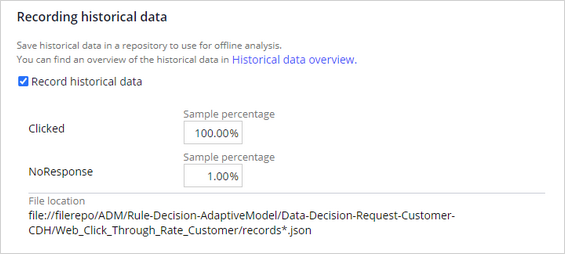
Exporting historical data
Learn how to extract historical data (predictors and outcomes) from adaptive models in your application to perform offline analysis or use the data to build models using the machine learning service of your choice.
Video
Transcript
This demo shows you how to export the customer interaction data that is used by adaptive models to make predictions, including all predictor data and associated outcomes, for offline analysis.
U+ Bank utilizes Pega Customer Decision Hub™ to present a personalized banner on its website, promoting credit card offers.
When a customer qualifies for multiple credit card options, adaptive models determine the card to display. If the customer disregards the banner, the adaptive model regards this as negative behavior. Conversely, when a customer clicks the banner, the model regards this as positive behavior.
Adaptive models are managed in Prediction Studio. The adaptive model that drives the decision over which banner to display is the Web Click Through Rate model. As a data scientist, you may want to inspect the raw predictor data used by an adaptive model and the customer interaction outcome to validate data assumptions and detect concept drift. You can also use the data to build various predictive models externally.
To extract the data, you enable the recording of historical data for the adaptive model.
A web banner typically has a low click-through rate and a significantly lower number of positive responses than negative responses. In such cases, you can sample all positive outcomes and just one percent of the negative outcomes to limit the storage space needed.
The system stores the predictor data and outcome as a JSON file in a repository of your choice.
A System Architect configures the repository in DEV Studio.
Supported repository types include Microsoft Azure and Amazon S3. In your repository, the system saves the JSON file in a designated folder.
Every record contains the predictor values used for the prediction, including decision, context and customer properties, and the outcome of the decision.
To use the JSON files for further analysis, import the files into a third-party analytics tool, for example the Pega Data Scientist tools.
Please keep in mind that when numerous customers access the website, the necessary storage space quickly expands to a substantial size.
You have reached the end of this demo. What did it show you?
- How to export the raw data that is used by adaptive models.
- What data is captured during a customer interaction.
This Topic is available in the following Modules:
If you are having problems with your training, please review the Pega Academy Support FAQs.
Want to help us improve this content?


